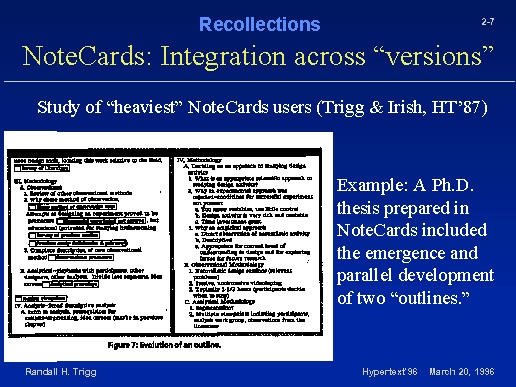| Previous slide
| Start of section
| Next slide
| Full text
| Full text w/ icons
| Home
|
Part 2: Recollections (7 of 12)
Frank Halasz said in 1991 that "Happiness is Notecards in the
rearview mirror." Indeed, his critique of NoteCards identified
vital issues for the field (a few of which we'll get to later). But in
thinking about the positive side of what we accomplished, I think
first of our users, a motley crew that were crucially "out of our
hands." Here's an example of how we learned from a user about a
rich sense of versioning, what we might call "chronological"
integration.[9] This is a tiny piece of a
NoteCards user's thesis notefile.
When he explained to Peggy Irish and me what he was up to, he
started from these two outlines - the "old" and the "new." But those
terms had a relative meaning at best. Both outlines had been around
for awhile and would persist usefully for some time to come. The
"transition" phase between them ended up comprising much of his
thesis work. Even if we could have provided automated support for
"restructuring" his hypertext world, he wouldn't have wanted it. In
fact, one of the things he liked best about NoteCards was the way it
let him live simultaneoulsy coming out of the old and into the new.
Here's hypermedia at its best - overlapping structures supporting
multiple views. This suggests defining the goal of integration as
supporting work that "rides" some boundary or transition -
supporting change, but at its own pace.
Last modified: Mon Sep 23 11:49:39 1996
Randy Trigg trigg@workpractice.com

